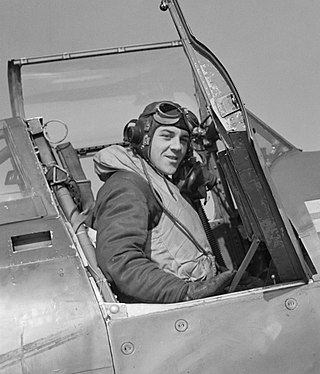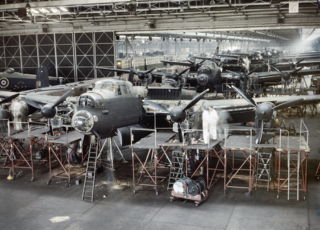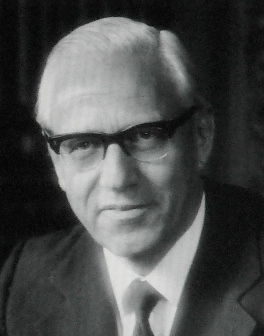
The British Aircraft Corporation (BAC) was a British aircraft manufacturer formed from the government-pressured merger of English Electric Aviation Ltd., Vickers-Armstrongs (Aircraft), the Bristol Aeroplane Company and Hunting Aircraft in 1960. Bristol, English Electric and Vickers became "parents" of BAC with shareholdings of 20%, 40% and 40% respectively. BAC in turn acquired the share capital of their aviation interests and 70% of Hunting Aircraft several months later.

The English Electric Lightning is a British fighter aircraft that served as an interceptor during the 1960s, the 1970s and into the late 1980s. It was capable of a top speed of above Mach 2. The Lightning was designed, developed, and manufactured by English Electric. After EE merged with other aircraft manufacturers to form the British Aircraft Corporation it was marketed as the BAC Lightning. It was operated by the Royal Air Force (RAF), the Kuwait Air Force (KAF), and the Royal Saudi Air Force (RSAF).

The English Electric Company Limited (EE) was a British industrial manufacturer formed after the armistice ending the fighting of World War I by amalgamating five businesses which, during the war, had been making munitions, armaments and aeroplanes.

Royal Air Force Coningsby or RAF Coningsby, is a Royal Air Force (RAF) station located 13.7 kilometres (8.5 mi) south-west of Horncastle, and 15.8 kilometres (9.8 mi) north-west of Boston, in the East Lindsey district of Lincolnshire, England. It is a Main Operating Base of the RAF and home to three front-line Eurofighter Typhoon FGR4 units, No. 3 Squadron, No. 11 Squadron and No. 12 Squadron. In support of front-line units, No. 29 Squadron is the Typhoon Operational Conversion Unit and No. 41 Squadron is the Typhoon Test and Evaluation Squadron. Coningsby is also the home of the Battle of Britain Memorial Flight (BBMF) which operates a variety of historic RAF aircraft.

Farnborough Airport is an operational business/executive general aviation airport in Farnborough, Rushmoor, Hampshire, England. The 310-hectare (770-acre) airport covers about 8% of Rushmoor's land area.

Royal Air Force Hooton Park or more simply RAF Hooton Park, on the Wirral Peninsula, Cheshire, is a former Royal Air Force station originally built for the Royal Flying Corps in 1917 as a training aerodrome for pilots in the First World War. During the early/mid-1930s, it was one of the two airfields handling scheduled services for the Merseyside region. Hooton Park was home to No. 610 Squadron and, post Second World War, to No. 611 and No. 663 (AOP) Squadron.

Filton Airport or Filton Aerodrome was a private airport in Filton and Patchway, within South Gloucestershire, 4 NM north of Bristol, England.

Wing Commander Roland Prosper "Bee" Beamont, was a British fighter pilot for the Royal Air Force (RAF) and an experimental test pilot during and after the Second World War. He was the first British pilot to exceed Mach 1 in a British aircraft in level flight (P.1A), and the first to fly a British aircraft at Mach 2 (P.1B).

Woodford Aerodrome is a former airfield and aircraft factory at Woodford, Greater Manchester, England, 6 NM north of Macclesfield. It was opened by the Avro company after the First World War and became an important production centre for military aircraft in the Second World War. Notable planes made at the factory include the Avro Anson, Avro Lancaster, Avro Shackleton and Avro Vulcan.

Warton Aerodrome is an airfield located in Warton village on the Fylde in Lancashire, England. It is 6 NM west of Preston, Lancashire. The western end of the site adjoins the village of Freckleton.

Brough Aerodrome was a private use aerodrome located at Brough, East Riding of Yorkshire, England. It is now disused with the last known flight out of the airfield occurring in 2011. The airfield closed in 2013. The site is now crossed by a new road "Baffin Way" serving the town.

Samlesbury is a village and civil parish in South Ribble, Lancashire, England. Samlesbury Hall, a historic house, is in the village, as is Samlesbury Aerodrome and a large modern brewery owned by Anheuser-Busch InBev. The population at the 2011 census was 1,206.
BAE Systems Military Air & Information is a business unit of British defence company BAE Systems responsible for the design, development, manufacture and support of fixed wing military aircraft. MAI customers include the Royal Air Force, Royal Saudi Air Force, US Navy and Indian Air Force.

The aerospace industry of the United Kingdom is the second-largest national aerospace industry in the world and the largest in Europe by turnover, with a global market share of 17% in 2019. In 2020, the industry employed 116,000 people.

Sir Frederick William Page was an English aircraft designer and manager. He had large involvements with two British aircraft projects - the English Electric Lightning and the BAC TSR.2. Arguably, the sum total of his contribution to the British aerospace community over a period of 45 years until his retirement in 1983 was greater than that of any other individual.

Royal Air Force Seighford or more simply RAF Seighford is a former Royal Air Force satellite station located 3.6 miles (5.8 km) northwest of Stafford, Staffordshire, England. The site was opened as a satellite/relief landing ground for RAF Hixon, 7.5 miles (12.1 km) to the east.
Thomas William Smith was a British aerospace engineer, and the team leader of the proposed BAC MUSTARD reusable spacecraft design.

Lancashire Aircraft Corporation was a major British charter airline after World War II. Its founding father was Eric Rylands. It played an important role in the Berlin Airlift. It also flew scheduled routes and was important in the development of Coach-air services, leading to the founding of Skyways Coach Air and the start of the Inclusive Tour (IT) industry. Its major subsidiary, Samlesbury Engineering, supported its operations and converted many military aircraft for commercial use, also founding Lancashire Aircraft Company.
Martin Hearn Ltd. was a British aviation company which during World War II played a major role in the assembly of thousands of American and Canadian aircraft imported to Liverpool by shipping convoys.

Bowland Forest Gliding Club is a British gliding club near the village of Chipping, Lancashire. It was formed as the Blackpool and Fylde Gliding Club in 1930, and is a members-only club, with no paid employees. It owns its airfield, generally called Chipping Airfield, but also known as Bowland Forest, Fiddlers Lane or Lower Cock Hill Farm.






















